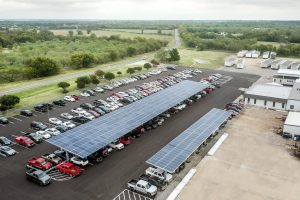Preface
While PPA’s have been a great tool to help spur solar adoption, there may be drawbacks depending on the situation of your organization, tax liability appetite, and future energy savings goals. In most cases, we recommend businesses evaluate and compare our Energy Savings Model against a PPA. The fact is a 3rd party will own your solar array, reaping in the advantageous federal tax credit benefits. In this article, we will discuss the general nature of power purchase agreements and how they are used.
What is a Solar Power Purchase Agreement?
A solar power purchase agreement (PPA) is a popular financial agreement among businesses. PPAs are where a developer arranges for the design, permitting, financing and installation of a solar energy system on a customer’s property at little to no upfront investment cost to the customer. It’s common for developers to sell the power generated to the customer at a fixed rate. This fixed rate can be lower than the local utility’s retail rate,and therefore can save customers money without having to put down any capital upfront.

The electricity price for the consumer can be lower and will offset the price of the customer’s purchase of electricity from the grid. The developer will take the income from the sales of electricity, and will also receive incentives from the system, such as federal or state tax credits. PPAs typically see lifespans from 10 to 25 years. During the duration of the agreement, the developer will maintain the responsibility for the operation and maintenance of the system. At the end of the contract term for the PPA, a customer has the option to extend the PPA, choose to have the developer uninstall the system, or purchase the complete solar PV system from the developer.
Benefits of PPAs to Solar Customers
No or low upfront capital costs: The developer is responsible for the beginning costs of sizing, procuring and installing the solar PV system as well as for any operations and maintenance the system may require. The developer will pay the cost to allow the customer to adopt to solar energy. This allows the customer to bypass the initial investment and start saving money by utilizing their solar energy system.
Reduced energy costs: Solar PPAs provide a fixed, predictable cost of electricity for the designated time of the agreement. The cost are designed in two ways.
The fixed Escalator Plan – the price the customer pays rises at a predetermined rate, typically between 2% – 5%. This is often lower than projected utility price increases.
The fixed Price Plan – the price will be constant throughout the term of the PPA. This will save the customer more as utility prices rise over time.
Limited risk: System performance and operating risk is the responsibility of the developer.
Better leverage of available tax credits: In most scenarios, developers can utilize available tax credits to reduce system costs. For example, municipal hosts and other public entities with no taxable income would not otherwise be able to take advantage of the Section 48 Investment Tax Credit.
Potential increase in property value: A solar PV system has been shown to increase value to residential and commercial properties. The longer durations to these agreements allows PPAs to be transferred with the property. Depending on the system set up however, this may or may not be feasible for commercial facilities.
Market Adoption and Policye
PPAs provide a way to avoid the initial capital costs of installing a solar PV system. PPAs allow a simple setup and turn-key use for its customers. In some states, however, the PPA model faces regulatory and legislative challenges that would regulate developers as electric utilities. A solar lease is third-party financing that is like a PPA. However, a solar lease does not involve the sale of electric power. Customers lease the system in the same way they would lease a car. In both cases, the system is owned by a third party, and the customer will have the benefits of solar with little or no initial costs. These third-party financing models are a popular way for customers to obtain the many benefits of solar energy. Colorado, for example, first entered the market in 2010 and by mid-2011 third-party installations represented over 60% of all residential installations and continued to rise to 75% through the first half of 2012. This upward trend is evident throughout states that have introduced third-party financing models.

PPA Considerations
SRECs: Solar renewable energy credits (SRECs) show the amount of electricity that was produced using solar energy. They are typically bought and sold by load serving entities (typically regulated utilities) to meet the standards that are corresponding to the state-level renewable energy standards. SRECs may be purchased by consumers for the use of voluntary marketing claims. Mostly in PPAs, the developer owns SRECs. When entering into a PPA, it will be important for a customer to take time to inquire about the ownership of SRECs, who can sell the SRECs generated from the PV system, the risks associated with SREC ownership, and the tradeoffs with respect to PPA price.
How to finance: Each third-party financing model has many benefits to consider. To any customer considering installing a solar PV system they should consider every financing option available, and choose their best fit. Here at Solar One, we analyze businesses and deliver our recommendations everyday for the best financing options specific to them.
Site upgrades: The developer is responsible for installation, operation and maintenance of a solar PV system. The host customer may consider making an investment in their property that would provide support for the installation of the system, lower the cost of installation or to comply with local ordinances. These investments may include rooftop repairs or trimming trees that could interfere with the PV system.
Possible higher property taxes: A PV system may help to increase the site’s property value, however there is also a potential risk of increase in property taxes. When a property is assessed, depending on which state the customer is in, there are certain policies in regards to property tax increase.
Summary
PPA’s used to be a great low cost option for companies to reduce energy costs immediately by purchasing electricity at a lower rate for a set number of years. Unfortunately the drawbacks of not owning the system, and giving away the tax benefits, were core reasons why Solar One developed their proprietary energy savings model, which combines the advantages of owning a solar system without any upfront cost, by using the tax credits to pay for the solar system.
Curious if PPA agreements are right for your business? Speak with a Solar Expert today.
Other Useful Resources
Common Commercial Solar Financing Models
Illinois Solar Incentives
Solar Energy FAQ
Solar Power Vocabulary 101
Illinois Solar Incentives